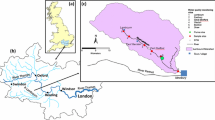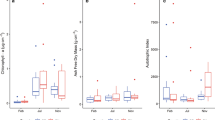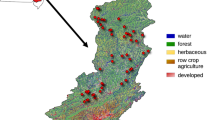Abstract
We investigated functional and structural responses of periphyton communities to simulated nonpoint source (NPS) pollution over a 2-year period. Periphyton communities were examined in three unique but hydrologically connected habitats in the lower Muskegon River: river, wetland, and lake. Our study addressed several major questions: (1) what are the effects of nonpoint source pollutants on periphyton structure and function, (2) to what degree do environmental conditions, including the pollutant delivery system and hydrologic conditions, affect periphyton response, and (3) do periphyton communities show synchronous responses to nonpoint source pollution? Nutrients were added over a 21-day period in each of the four seasons over 2 years. The effect of road salt on metabolism was evaluated in the winter and spring seasons in the river habitat only. In general, the periphyton community showed complex responses to the NPS amendments, but there was little evidence of nutrient limitation in this system based on community structure, biomass accrual, metabolism, or alkaline phosphatase activity. This result was unexpected given the relatively low ambient concentrations of phosphorus. We discuss the possibilities that nutrient delivery was ineffective or that herbivory and/or irradiance might have constrained periphyton growth, but ultimately conclude that our results suggest that periphyton communities in the lower Muskegon River watershed were (1) nutrient-replete, (2) tolerant of short-term salt additions, and (3) influenced more by local conditions (habitat) than by regional (watershed) factors. In systems where nonpoint source pollutant delivery is diffuse and hydrologic residence time is short, the influence of nonpoint source pollutants on periphyton may be either modest or too difficult to detect using traditional endpoints.








Similar content being viewed by others
References
Allan JD (2004) Landscapes and riverscapes: the influence of land use on stream ecosystems. Annu Rev Ecol Syst 35:257–284
Allen NS, Hershey AE (1996) Seasonal changes in chlorophyll a response to nutrient amendments in a North Shore tributary of Lake Superior. J N Am Benthol Soc 15:170–178
APHA (1998) Standard methods for the examination of water and waste water. American Public Health Association, Washington
Baines SB, Webster KE, Kratz TK, Carpenter SR, Magnuson JJ (2000) Synchronous behavior of temperature, calcium, and chlorophyll in lakes of northern Wisconsin. Ecology 81:815–825
Bernhardt ES, Likens GE (2004) Controls on periphyton biomass in heterotrophic streams. Freshw Biol 49:14–27
Biggs BJF (1988) Algal proliferations in New Zealand’s shallow stony foothills-fed rivers: toward a predictive model. Verh Internat Verein Theor Angew Limnol 23:1405–1411
Biggs BJF (1996) Patterns in benthic algae of streams. In: Stevenson RJ, Bothwell ML, Lowe RL (eds) Algal ecology. Academic Press, San Diego, pp 31–56
Boisson JC, Perrodin Y (2006) Effects of road runoff on biomass and metabolic activity of periphyton in experimental streams. J Haz Mat A132:148–154
Borchardt MA (1996) Nutrients. In: Stevenson RJ, Bothwell ML, Lowe RL (eds) Algal ecology. Academic Press, San Diego, pp 184–228
Bothwell ML (1989) Phosphorus-limited growth dynamics of lotic periphytic diatom communities: areal biomass and cellular growth rate responses. Can J Fish Aquat Sci 46:1293–1301
Bowman MF, Chambers PA, Schindler DW (2005) Epilithic algal abundance in relation to anthropogenic changes in phosphorus bioavailability and limitation in mountain rivers. Can J Fish Aquat Sci 62:174–184
Brett MT, Arhonditsis GB, Mueller SE, Hartley DM, Frodge JD, Funke DE (2005) Non-point-source impacts on stream nutrient concentrations along a forest to urban gradient. Environ Manage 35:330–342
Carpenter SR, Caraco NF, Correll DL, Howarth RW, Sharpley AN, Smith VH (1998) Nonpoint pollution of surface waters with phosphorus and nitrogen. Ecol Appl 8:559–568
Corsi SR, Graczyk DJ, Geis SW, Booth NL, Richards KD (2010) A fresh look at road salt: aquatic toxicity and water-quality impacts on local, regional, and national scales. Environ Sci Technol 44:7376–7382
Daley ML, Potter JD, McDowell WH (2009) Salinization of urbanizing New Hampshire streams and groundwater: effects of road salt and hydrologic variability. J N Am Benthol Soc 28:929–940
Delong MD, Brusven MA (1992) Patterns of periphyton chlorophyll a in an agricultural nonpoint source impacted stream. Water Res Bull 28:731–741
Demars BOL, Manson JR, Ólafsson JS, Gíslason GM, Gudmundsdóttir R, Woodward G, Reiss J, Pichler DE, Rasmussen JJ, Friberg N (2011) Temperature and the metabolic balance of streams. Freshwat Biol 56:1106–1121
DeNicola D (1996) Periphyton responses to temperature at difference ecological levels. In: Stevenson RJ, Bothwell ML, Lowe RL (eds) Algal ecology. Academic Press, San Diego, pp 149–181
Dodds WK, Welch EB (2000) Establishing nutrient criteria in streams. J N Am Benthol Soc 19:186–196
Dodds WK, Smith VH, Lohman K (2002) Nitrogen and phosphorus relationships to benthic algal biomass in temperate streams. Can J Fish Aquat Sci 59:865–874
Dodds WK, Bouska WW, Eitzmann JL, Pilger TJ, Pitts KL, Riley AJ, Schloesser JT, Thornbrugh DJ (2009) Eutrophication of US freshwaters: analysis of potential economic damages. Environ Sci Technol 43:12–19
Elsdon TS, Limburg KE (2008) Nutrients and their duration of enrichment influence periphyton cover and biomass in rural and urban streams. Mar Freshwat Res 59:467–476
Espeland EM, Francoeur SN, Wetzel RG (2002) Microbial phosphatase in biofilms: a comparison of whole community enzyme activity and individual bacterial cell-surface phosphatase expression. Arch Hydrobiol 153:581–593
Evans-White MA, Lamberti GA (2006) Stoichiometry of consumer-driven nutrient recycling across nutrient regimes in streams. Ecol Lett 9:1186–1197
Fisher MM, Triplett EW (1999) Automated approach for ribosomal intergenic spacer analysis of microbial diversity and its application to freshwater bacterial communities. Appl Environ Microbiol 65:4630–4636
Francoeur SN (2001) Meta-analysis of lotic nutrient amendment experiments: detecting and quantifying subtle responses. J N Am Benthol Soc 20:358–368
Francoeur SN, Biggs BJF, Smith RA, Lowe RL (1999) Nutrient limitation of algal biomass accrual in streams: seasonal patterns and a comparison of methods. J N Am Benthol Soc 18:242–260
Gardner KM, Royer TV (2010) Effect of road salt application on seasonal chloride concentrations and toxicity in south-central Indiana streams. J Environ Qual 39:1036–1042
Genter RB (1996) Ecotoxicology of inorganic chemical stress to algae. In: Stevenson RJ, Bothwell ML, Lowe RL (eds) Algal ecology. Academic Press, San Diego, pp 403–468
Greenwood JL, Rosemond AD (2005) Periphyton response to long-term nutrient enrichment in a shaded headwater stream. Can J Fish Aquat Sci 62:2033–2045
Healey FP (1973) Inorganic nutrient uptake and deficiency in algae. Crit Rev Microbiol 3:69–113
Helsel DR (1990) Less than obvious: statistical treatment of data below the detection limit. Environ Sci Technol 24:1767–1774
Hewitt JE, Thrush SE, Cummings VJ (2001) Assessing environmental impacts: effects of spatial and temporal variability at likely impact scales. Ecol Appl 11:1502–1516
Hill WR, Boston HL, Steinman AD (1992) Grazers and nutrients simultaneously limit lotic primary productivity. Can J Fish Aquat Sci 49:504–512
Hillebrand H (2002) Top-down versus bottom-up control of autotrophic biomass—a meta-analysis on experiments with periphyton. J N Am Benthol Soc 21:349–369
Jackson RB, Jobbágy EG (2005) From icy roads to salty streams. Proc Natl Acad Sci USA 102:14487–14488
Johnson LT, Tank JL, Dodds WK (2009) The influence of land use on stream biofilm nutrient limitation across eight North American ecoregions. Can J Fish Aquat Sci 66:1081–1094
Johnson KA, Steinman AD, Keiper WD, Ruetz CR III (2011) Biotic responses to low-concentration urban road runoff. J N Am Benthol Soc 30:710–727
Kaushel SS, Groffman PM, Likens GE, Belt KT, Stack WP, Kelly VR, Band LE, Fisher GT (2005) Increasing salinization of fresh water in the northeastern United States. Proc Natl Acad Sci USA 201:13517–13520
Kling GW, Kipphut GW, Miller MM, O’Brien WJ (2000) Integration of lakes and streams in a landscape perspective: the importance of material processing on spatial patterns and temporal coherence. Freshw Biol 43:477–497
Kratz TK, Soranno PA, Baines SB, Benson BJ, Magnuson JJ, Frost TM, Lathrop R (1998) Interannual synchronous dynamics in north temperate lakes in Wisconsin, USA. In: George DG, Jones JG, Punčochář P, Reynolds CS, Sutcliffe DW (eds) Management of lakes and reservoirs during global climate change. Kluwer Academic, Dordrecht, Germany, pp 273–287
Lamberti G (1996) The role of periphyton in benthic food webs. In: Stevenson RJ, Bothwell ML, Lowe RL (eds) Algal ecology. Academic Press, San Diego, pp 533–572
Larned ST (2010) A prospectus for periphyton: recent and future ecological research. J N Am Benthol Soc 29:182–206
Larned ST, Nikora ST, Biggs BJF (2004) Mass-transfer-controlled nitrogen and phosphorus uptake by stream periphyton: a conceptual model and experimental evidence. Limnol Oceanogr 49:1992–2000
Liess A, Lange K, Schulz F, Piggott JJ, Matthaei CD, Townsend CR (2009) Light, nutrients, and grazing interact to determine diatom species richness via changes to productivity, nutrient state and grazer activity. J Ecol 97:326–336
Magnuson JJ, Benson BJ, Kratz TK (1990) Temporal coherence in the limnology of a suite of lakes in Wisconsin, USA. Freshw Biol 23:145–159
Mulholland PJ, Rosemond AD (1992) Periphyton response to longitudinal nutrient depletion in a woodland stream: evidence of upstream—downstream linkage. J N Am Benthol Soc 11:405–419
Mulholland PJ, Webster JR (2010) Nutrient dynamics in streams and the role of J-NABS. J N Am Benthol Soc 29:100–117
Ogdahl ME, Lougheed VL, Stevenson RJ, Steinman AD (2010) Influences of multi-scale habitat on metabolism in a coastal Great Lakes watershed. Ecosystems 11:222–238
Paerl HW, Fulton RS, Moisander PH, Dyble J (2001) Harmful freshwater algal blooms, with an emphasis on cyanobacteria. The Scientific World 1:76–113
Quinn JM, Cooper AB, Davies-Colley RJ, Rutherford JC, Williamson RB (1997) Land use effects on habitat, water quality, periphyton, and benthic invertebrates in Waikato, New Zealand, hill-country streams. New Zeal J Mar Freshw Res 315:579–597
Rosemond AD (1993) Interactions among irradiance, nutrients, and herbivores constrain a stream algal community. Oecologia 94:585–594
Royer TV, David MB, Gentry LE, Mitchell CA, Starks KM (2008) Assessment of chlorophyll-a as a criterion for establishing nutrient standards in the streams and rivers of Illinois. J Environ Qual 37:437–447
Sansalone JJ, Cristina CM (2004) First flush concepts for suspended and dissolved solids in small impervious watersheds. J Environ Eng 130:1301–1314
Silver P, Rupprecht SM, Stauffer MF (2009) Temperature-dependent effects of road deicing salt on chironomid larvae. Wetlands 29:942–951
Steinman AD (1996) Effects of grazers on freshwater benthic algae. In: Stevenson RJ, Bothwell ML, Lowe RL (eds) Algal ecology. Academic Press, San Diego, pp 341–373
Steinman AD, Mulholland PJ (2006) Phosphorus limitation, uptake, and turnover in benthic stream algae. In: Hauer FR, Lamberti GA (eds) Methods in stream ecology, 2nd edn. Academic Press/Elsevier, Burlington, pp 187–212
Steinman AD, Lamberti GA, Leavitt P (2006) Biomass and pigments of benthic algae. In: Hauer FR, Lamberti GA (eds) Methods in stream ecology, 2nd edn. Academic Press/Elsevier, Burlington, pp 357–379
Steinman AD, Ogdahl M, Rediske R, Ruetz CR III, Biddanda BA, Nemeth L (2008) Current status and trends in Muskegon Lake, Michigan. J Great Lakes Res 34:169–188
Stevenson RJ, Peterson CG, Kirschtel DB, King DB, King CC, Tuchman NC (1991) Density-dependent growth, ecological strategies, and effects of nutrients and shading on benthic diatom succession in streams. J Phycol 27:59–69
Stevenson RJ, Hill BH, Herlihy AT, Yuan LL, Norton SB (2008) Algae-P relationships, thresholds, and frequency distribution guide nutrient criterion development. J N Am Benthol Soc 27:783–799
Stewart-Oaten A, Murdoch WW, Parker KR (1986) Environmental impact assessment: “pseudoreplication” in time? Ecology 67:929–940
Stewart-Oaten A, Bence JR, Osenberg CW (1992) Assessing effects of unreplicated perturbations: no simple solutions. Ecology 73:1396–1404
Stumborg BE, Baerenklau KA, Bishop RC (2001) Nonpoint source pollution and present values: a contingent valuation study of Lake Mendota. Rev Agric Econ 23:120–132
Tank JL, Bernot MJ, Rosi-Marshall EJ (2006) Nitrogen limitation and uptake. In: Hauer FR, Lamberti GA (eds) Methods in stream ecology, 2nd edn. Academic Press/Elsevier, Burlington, pp 213–238
U.S. Environmental Protection Agency (1983) Methods for chemical analysis of water and wastes. U.S. Environmental Protection Agency, Cincinnati, OH. EPA-600-/4-79-020
U.S. Environmental Protection Agency (2009) National water quality inventory: report to Congress. 2004 reporting cycle. Office of Water, U.S. Environmental Protection Agency, Washington, DC. EPA Report 841-R-08-001
Worm B, Reusch TBH, Lotze HK (2000) In situ nutrient enrichment: methods for marine benthic ecology. Internat Rev ges Hydrobiol 85:359–375
Yannarell AC, Triplett EW (2005) Geographic and environmental sources of variation in lake bacterial community composition. Appl Environ Microbiol 71:227–239
Acknowledgments
We express our gratitude to Matt Cooper, Pete Hrodey, Adam Bosch, Eric Nemeth, Lori Nemeth, Aaron Parker, Jeffrey Berkebile, Nathan Maier, Mandi Seeger, Heidi Zajack, and Megan Zemke for their assistance with fieldwork and laboratory processing. Discussions with Pat Mulholland and Steve Francoeur regarding our findings improved the manuscript. Comments from Gary Lamberti and an anonymous reviewer improved the manuscript and are greatly appreciated. Funding was provided by the U.S. Department of Education under grant award U215K050182.
Author information
Authors and Affiliations
Corresponding author
Additional information
Handling Editor: Michael T. Monaghan.
Electronic supplementary material
Below is the link to the electronic supplementary material.
10452_2011_9366_MOESM1_ESM.tif
Mean (±SE) alkaline phosphatase activity (APA) of periphyton on clay tiles collected from NPS experimental arrays: A) river, B) wetland, C) lake. B = Before nutrients (i.e., day 0); A = After nutrients (i.e., day 21). * denotes statistical significance at P < 0.05 (TIFF 32819 kb)
Rights and permissions
About this article
Cite this article
Steinman, A.D., Ogdahl, M.E., Wessell, K. et al. Periphyton response to simulated nonpoint source pollution: local over regional control. Aquat Ecol 45, 439–454 (2011). https://doi.org/10.1007/s10452-011-9366-8
Received:
Accepted:
Published:
Issue Date:
DOI: https://doi.org/10.1007/s10452-011-9366-8




